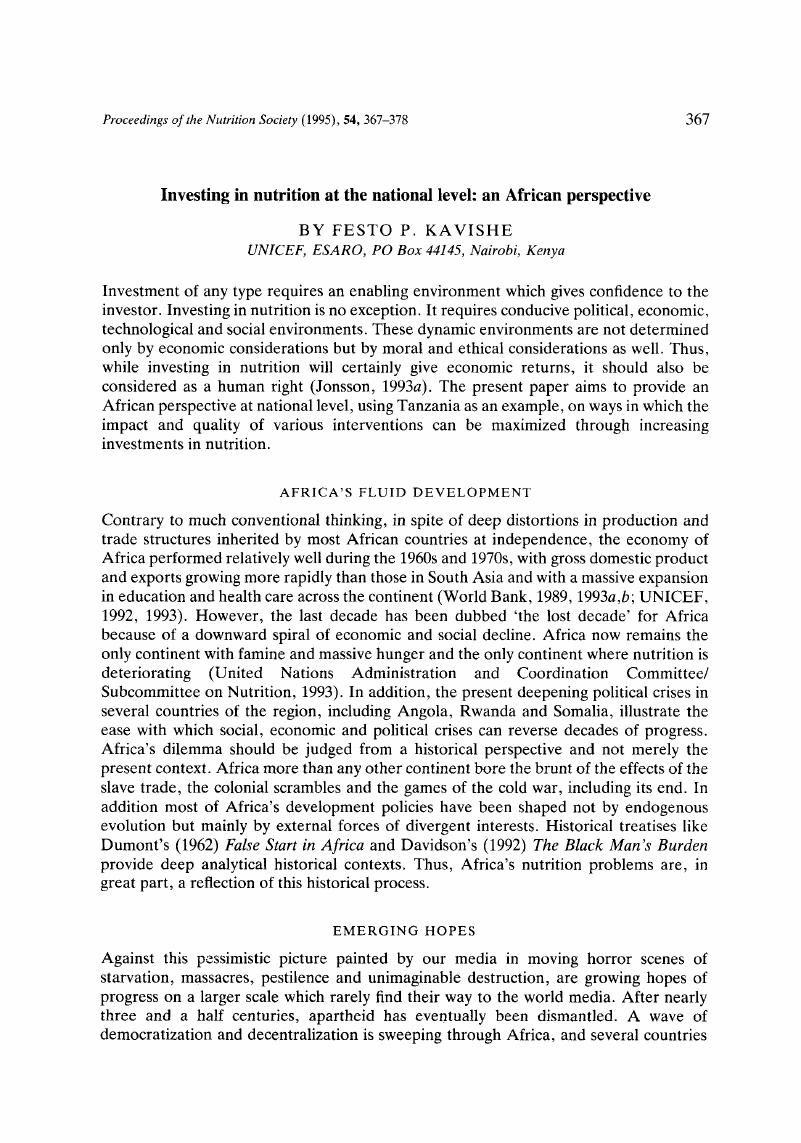No CrossRef data available.
Article contents
Investing in nutrition at the national level: an African perspective
Published online by Cambridge University Press: 28 February 2007
Abstract
An abstract is not available for this content so a preview has been provided. As you have access to this content, a full PDF is available via the ‘Save PDF’ action button.

- Type
- Symposium on ‘Investing in nutrition: maximizing returns’
- Information
- Copyright
- Copyright © The Nutrition Society 1995
References
Berg, A. (1991). Sliding Toward Nutrition Malpractice: Time to Reconsider and Redeploy. Martin Forman Memorial Lecture. Presented at the Annual General Meeting of the National Center for International Health, Washington, DC, 24 06, 1991. Washington, DC: National Center for International Health.Google Scholar
Berg, A. (1993). Malnutrition and ‘nutrition engineering’ in low income countries: A rejoinder. International Journal of Health Services 23, 615–619.CrossRefGoogle ScholarPubMed
Csete, J. (1993). Malnutrition and ‘nutrition engineering’ in low income countries: A comment on Alan Berg's vision of the nutrition track record. International Journal of Health Services 23, 607–614.CrossRefGoogle ScholarPubMed
Davidson, B. (1992). The Black Man's Burden. Africa and the Curse of the Nation-State. Washington, DC: Times Books.Google Scholar
Jonsson, U. (1988). A Conceptual Approach to Understanding and Explanation of Hunger and Malnutrition in Society. Hunger and Society. Cornell International Monograph series no. 17.Google Scholar
Jonsson, U. (1993 a). Nutrition and the United Nations Convention on the Rights of the Child. Innocenti Occasional Papers. Child Rights Series no. 5. New York: UN.Google Scholar
Jonsson, U. (1993 b). The global embarrassment of malnutrition and the role of nutrition engineers. Letter to the editor. International Journal of Health Services 23, 579–580.Google Scholar
Kavishe, F. P. & Mushi, S. S. (1993). Nutrition-relevant Actions in Tanzania. TFNC Monograph Series no. 1. UN ACCISCN Country Study Supported by UNICEF. A Case Study for the XV Congress of the International Union of Nutritional SciencesSeptember 26 to October 1, 1993Adelaide.Google Scholar
Ndossi, G. (1994). Resource Flows and Programmatic Actions for the Achievement of ICN Goals in Tanzania. TFNC Report no. 1632, May, 1994.Google Scholar
Unicef (1992). Africa's Recovery in the 1990s. From Stagnation and Adjustment to Human Development [Cornia, G. A., van der Houven, R. and Mkandawire, T., editors]. Spedale degli Innocenti Florence, Italy: International Child Development Centre.Google Scholar
Unicef (1993). We Will Never Go Back. Social Mobilization in the Child Survival and Development Programme in the United Republic of Tanzania. New York: UNICEF.Google Scholar
Unicef (1994). The Progress of Nations, 1994. The Nations of the World Ranked According to Their Achievements in Child Health, Nutrition, Education, Family Planning and Progress for Women. New York: UNICEF.Google Scholar
United Nations Administration and Coordination Committee/Subcommittee on Nutrition (1992). Second Report on the World Nutrition Situation, vol. 1, pp. 17–36. Geneva: ACC/SCN.Google Scholar
US Agency for International Development (1992). International Conference on Nutrition. World Declaration and Plan of Action for Nutrition. Rome, 12 1992. Washington, DC: USAID.Google Scholar
World Bank (1989). Sub-Saharan Africa: From Crisis to Sustainable Growth. Washington, DC: World Bank.Google Scholar
World Bank (1993 a). World Development Report 1993: Investing in Health. Oxford: Oxford University Press.Google Scholar
World Bank (1993 b). A Framework and Indicative Cost Analysis for Better Health in Africa. Africa Technical Department, Human Resources and Poverty Division, Technical Working Paper no. 8. Washington, DC: World Bank.Google Scholar


